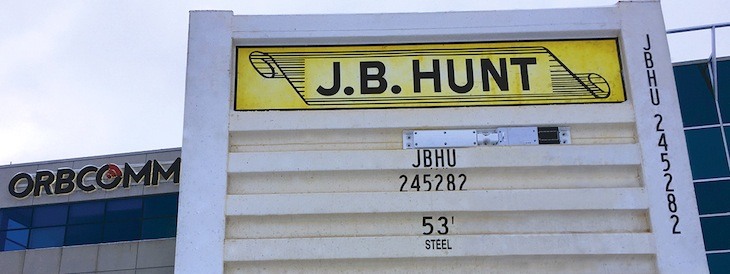J.B. Hunt offers earnings guidance, analysts expect $1.42 per share in third quarter
by October 10, 2018 5:30 pm 627 views

Lowell-based carrier J.B. Hunt Transport Services is expected to report third-quarter profit to rise 56% to $1.42 per share, based on a consensus of 22 analysts, but that estimate was before the company announced legal payments would affect earnings for the period by 26 cents per share.
The company plans to report earnings, for the period ending Sept. 30, after the markets close Monday (Oct. 15). Also, the company will host a conference call to discuss the financial report. It usually reports before markets open in a press release and without a conference call to discuss the results.
Based on average estimates from 15 analysts, revenue is expected to rise $20.3% to $2.22 billion.
The carrier announced Wednesday (Oct. 10) it would pay several pre-tax charges totaling $39 million and would affect earnings by $28.9 million, or 26 cents per share, in the third quarter and for 2018. The charges relate to an arbitration between the company and Fort Worth, Texas-based BNSF Railway Co., lawsuit settlements with regard to driver pay and rest breaks and a customer bankruptcy.
In a third-quarter earnings preview, analysts Brad Delco and Justin Long and associates Scott Schoenhaus and Brian Colley, all of Little Rock-based Stephens Inc., lowered third-quarter earnings estimates by 6 cents to $1.35 per share before J.B. Hunt released the financial guidance.
“In short, we believe (J.B. Hunt) has had a lot of success winning multiple large dedicated service awards and as a result will experience some ‘startup’ costs in the quarter,” according to Delco, Long, Schoenhaus and Colley. “Importantly, we believe this should only be viewed as a temporary issue, which ultimately should strengthen (J.B. Hunt’s) growth outlook for 2019.”
Stephens gives a buy rating to the carrier’s stock and a 12-month target of $138 per share.
Shares of J.B. Hunt (NASDAQ: JBHT) closed Wednesday at $113.93, down $4.24 or 3.59%. In the past 52 weeks, the stock has ranged between $131.74 and $100.25.
Intermodal
Volumes in the intermodal segment, which is the carrier’s largest by revenue and operating income, were impacted by rail service that deteriorated from the second quarter, and volume growth for the third quarter was revised to 2.5%, from 3%, according to Delco, Long, Schoenhaus and Colley. Recently, West Coast inbound container data showed a pull forward in demand ahead of tariffs and concerns of whether there will be enough capacity to move freight later this year. The analysts increased their estimate for revenue per load to 14%, from 12%, as they believed pricing was better than previously expected.
Dedicated Contract Services
The dedicated segment has been successful in landing new business in the third quarter, and this will impact its operating ratio as it hires staff and purchases equipment, said Delco, Long, Schoenhaus and Colley. From the second quarter, the ratio is expected to degrade 200 basis points to 91%. Operating ratio is a company’s operating expenses as a percentage of revenue.
Integrated Capacity Solutions
The carrier’s brokerage or logistics segment saw robust growth in the third quarter, with top-line revenue expected to rise 42.5% after increasing revenue estimates for the period, according to Delco, Long, Schoenhaus and Colley. Gross margins will be flat at 14.8%, compared to the previous estimate of 13.8%, as spot rates moderated and capacity loosened, which is normal for the period. Operating ratio should be 96.7%, and it degraded 40 basis points from the previous estimate as a result of continued investment into staff.
Trucking
The truckload segment continues to benefit from a strong freight market with pricing up 13%, from the same period in 2017, and flat from the second quarter, according to Delco, Long, Schoenhaus and Colley. Truck usage is expected to decline 0.5%, from the same period in 2017, and compared to a 4.4% decline in the second quarter. The biggest challenge has been finding drivers for trucks, but the segment’s operating ratio should be 91.5%, and improvement of 110 basis points from the previous quarter.
